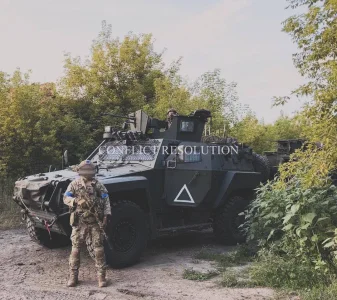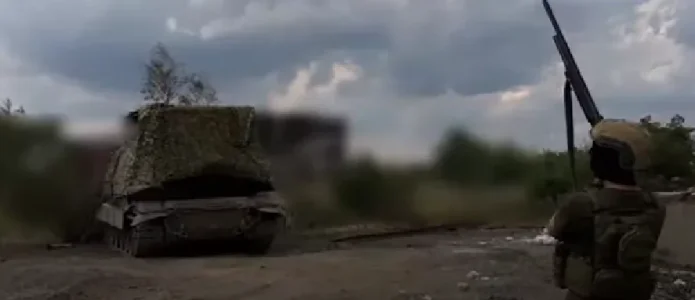- Joined
- Aug 24, 2024
- Messages
- 547
- Likes
- 701
21.08.2024 Author: Brian BerleticI was talking about Selidovo. It's a question for several months.
As for Lukashenko's regime, it will be overthrown. Just not now. Now we will resolve the issue of Russia's aggression. He thinks that he has strangled his own opposition, but his rating among the Belarusian people is 3%
That's why I am surprised when they talk about Pokrovsk as if the issue has been resolved. I don't have maps of the operational headquarters, but in August Ukraine captured 1,300 square kilometers in the Kursk region. This is more than the Russian army captured in 8 months. And that part of the Donetsk region is flat steppe. There are very small rivers there, but they can be jumped over. How much more territory we will capture is a question with an asterisk. The Russian army is forced to transfer its troops from the Kharkov and Kherson directions. Accordingly, we are pressing in these places (it was not for nothing that I mentioned villages in the Belgorod oblast).
Kursk: Fighting Russia to the Last Ukrainian

In the lead up to the Ukrainian military’s incursion into Russia’s Kursk region, even Western headlines were dominated by reports of Ukraine’s gradual demise. Ukraine is admittedly suffering arms and ammunition shortages, as well as facing an unsolvable manpower crisis. Russia has been destroying Ukrainian military power faster than Ukraine and its Western sponsors can reconstitute it.
Western headlines have also been admitting the scale on which Russia is expanding its own military power as its Special Military Operation (SMO) continues into its third year.
While the launch of Ukraine’s incursion into Kursk has diverted attention away from Ukraine’s collapsing fighting capacity, the incursion itself has not only failed to address the factors leading to this collapse, it is already accelerating it.
Politico in an August 15, 2024 article titled, “As Kyiv makes gains in Kursk, Russia strikes back in Donetsk,” cites the spokesman of Ukraine’s 110th Mechanized Brigade who would admit, “since Ukraine launched the Kursk offensive I would say things have become worse in our part of the front. We have been getting even less ammo than before, and the Russians are pushing.”
The same article would also cite “Deep State,” a mapping project Politico claims is “close” to Ukraine Ministry of Defense, claiming, “over the past 24 hours, Russia occupied the villages of Zhelanne and Orlivka and made advances in New York, Krasnohorivka, Mykolaivka and Zhuravka in Donetsk.”
Thus, while Ukraine claims gains in Kursk, it comes at the expense of territory everywhere else along the line of contact.
Because of the nature of the fighting in Kursk where Ukrainian forces have come out from behind extensive defensive lines and are operating out in the open, they are suffering much greater losses than Ukrainian units being pushed back along the line of contact, according to even the Western media.
Superficial Success, Strategic Suicide
Despite this reality, the Western media has invested heavily in depicting Ukraine’s Kursk incursion as a turning point in the fighting.
CNN in its August 15, 2024 article, “Russia appears to have diverted several thousand troops from occupied Ukraine to counter Kursk offensive, US officials say,” attempts at first glance to portray the Ukrainian operation as having successfully diverted Russian forces from the front lines.
Buried deeper in the article, however, CNN reveals that whatever troops Russia is moving are relatively insignificant compared to the number of Russian forces still fighting along the line of contact primarily in Kherson, Zaporozhye, the Donbass, and Kharkov.
In the short-term, experienced forces utilized as a mobile reserve are likely being moved to Kursk until Russian reserves within Russia itself can be sufficiently mobilized and moved to the area of fighting. The vast majority of Russia’s forces not only remain along the actual line of contact, they continue making progress at an accelerated rate.
The same CNN article would quote US officials, saying:
Buried under optimistic headlines across the Western media regarding this latest incursion is an ominous truth – that an operation aimed at humiliating Russia, boosting morale, and raising the political, territorial, and military costs for Russia, has only brought Ukraine deeper into its growing arms, ammunition, and manpower crisis.Some officials also raised concerns that Ukraine, which one western official said has sent some of its more experienced forces into Kursk, may have created weaknesses along its own frontlines that Russia may be able to exploit to gain more ground inside Ukraine.
“It’s impressive from a military point of view,” the official said of the Kursk operation. But Ukraine is “committing pretty experienced troops to this, and they can’t afford to lose those troops.”
“And having diverted them from the front line creates opportunities for Russia to seize advantage and break through,” this person added.
Toward what end does an incursion accelerating the collapse of Ukraine’s fighting capacity serve?
Washington’s, Not Kiev’s Ends
CNN would also attempt to convince readers that the Kursk incursion took the US itself entirely by surprise. This is untrue.
The United States, following its political capture of Ukraine in 2014, admittedly took over Ukraine’s intelligence networks. These are the same networks that would have been required to organize this most recent incursion.
A New York Times article, “The Spy War: How the C.I.A. Secretly Helps Ukraine Fight Putin,” not only admits to the CIA’s role in training, shaping, and directing Ukrainian intelligence operations, but also admits to a network of CIA bases along the Ukrainian-Russian border and the fact that the CIA stood up covert military units specifically for crossing over into Russian territory and conducting operations there.
The CIA and other US military and intelligence agencies have been involved in Ukrainian military operations leading up to and all throughout the duration of Russia’s SMO. The Washington Post admits that the US worked with Ukraine to “build a campaign plan” ahead of the failed 2023 Ukrainian offensive.
It is inconceivable Ukraine moved multiple brigades of manpower and equipment, including US-European trained soldiers and Western military equipment to Sumy where the Kursk incursion was launched without Washington’s involvement, let alone without Washington’s knowledge.
Why then did the US organize such an incursion, one admittedly overstretching Ukrainian forces already crumbling under the growing weight of Russian military power? Why, amid Russia’s strategy of attrition, have US planners decided to launch an incursion that will accelerate the loss of Ukrainian manpower, arms, and ammunition it does not have to spare?
In a much wider geopolitical context – Washington’s geopolitical context – the incursion helps raise the cost of victory for Russia in Ukraine as the US seeks to place pressure on and overextend Russia elsewhere within and along its borders.
Years before the SMO even began, as far back as at least 2019, US policymakers openly sought to draw Russia into a costly conflict in Ukraine, just one among many other proposals meant to overextend Russia.
The RAND Corporation in its 2019 paper “Extending Russia” would explain the benefits of “providing lethal aid to Ukraine,” stating:
Ukraine’s incursion into Kursk has – at a minimum – raised the political cost of Russia’s ongoing SMO. This most recent incursion into Kursk almost certainly had hoped to reach the Kursk Nuclear Power Plant, just 35 kilometers beyond the furthest extent the incursion has reached as of this writing. Had Ukrainian forces reached the power plant, the price would have been even higher.Expanding U.S. assistance to Ukraine, including lethal military assistance, would likely increase the costs to Russia, in both blood and treasure, of holding the Donbass region. More Russian aid to the separatists and an additional Russian troop presence would likely be required, leading to larger expenditures, equipment losses, and Russian casualties. The latter could become quite controversial at home, as it did when the Soviets invaded Afghanistan.
In many ways, however, the Kursk incursion has created a much greater strategic dilemma for Ukraine that it has for Russia. While it has unfolded on the wrong side of the border, the outcome is the same as the Kharkov front Russia opened earlier this year.
Regarding the Kharkov front, the New York Times in its May 2024 article, “Facing Russian Advance, a Top Ukrainian General Paints a Bleak Picture,” would admit, “the Russian attacks in the northeast are intended to stretch Ukraine’s already thin reserves of soldiers and divert them from fighting elsewhere,” and that, “the Ukrainian army was trying to redirect troops from other front-line areas to shore up its defenses in the northeast, but that it had been difficult to find the personnel.”
By committing thousands of Ukrainian troops and large amounts of Ukraine’s best military equipment to an incursion into Kursk, it is creating the same overextension of its own forces Russia had created in Kharkov last May, but with the added complication of needing to extend logistics and other means of supporting Ukrainian operations beyond Ukrainian territory itself.
The same RAND Corporation paper proposing to draw Russia into a costly conflict with Ukraine would also discuss the consequences this conflict would have for Ukraine itself, explaining:
The plan from the very beginning was to lure Russia into a costly conflict in the hopes of precipitating a Soviet-style collapse, but at the expense of Ukraine’s own survival. Thus, what we see unfolding in Ukraine today is simply the consequences predicted by the RAND Corporation in 2019.…such a move might also come at a significant cost to Ukraine and to U.S. prestige and credibility. This could produce disproportionately large Ukrainian casualties, territorial losses, and refugee flows. It might even lead Ukraine into a disadvantageous peace.
Dangerous Escalation and the Long Game
Perhaps most concerning of all is the looming prospect of the US intervening more directly, including in the form of a “buffer zone” similar to that created by the US and its Turkish allies in the east and north of Syria during Washington’s proxy war there.
For this intervention to succeed, Russia would have to be compelled to restrain itself from attacking Western forces arriving in Ukraine.
The possibility of this happening is difficult to predict.
On one hand, Russia has demonstrated immense patience amid other US proxy wars. Russian patience in Syria is finally paying off after almost a decade of enduring US provocations and the presence of US troops east of the Euphrates River. The US now finds itself isolated and vulnerable in Syria, its forces under regular attack there, and a disproportionate amount of US military hardware remains committed to both Syria and the surrounding region, limiting US combat power ahead of a potential conflict with Russia in Eastern Europe or China in the Asia-Pacific.
Moscow may determine that a Western intervention directly into Ukraine will, over time, collapse under its own weight in a similar manner. In the long term, the US is only going to grow weaker and more isolated as a result of its unsustainable, overreaching foreign policy. Initiating direct conflict with the US now, when it is inevitably going to be weaker later, would be permitting the US a potential and unnecessary advantage.
Instead, Russia and its allies may find an opportunity to exercise many of the means of escalation (short of direct conflict with the US itself) they have held in reserve throughout the duration of this conflict. This includes more open and direct military cooperation between Russia and China, including the arming of Russian forces with Chinese manufactured weapons and ammunition.
On the other hand, Russia may decide to restrain itself from attacking Western forces arriving in Ukraine’s westernmost regions, but continue military operations along the line of contact and obviously within Kursk itself to expel Ukrainian forces. The US would seek to test the limits of Russian resolve, seeking to constrain Russian operations as much as possible, just as the US did in Syria from 2015 onward.
Throughout this process, the potential for escalation and direct conflict between Russia and the US will grow.
Despite the continued collapse of Ukraine’s fighting capacity because Ukraine is ultimately a proxy of the United States, a difficult and dangerous transition period lies ahead dependent on the extent to which the US seeks to mitigate Ukraine’s subsequent political and territorial collapse.
Only time will tell whether the US cuts and runs as it did in Afghanistan, or doubles down as it did in Syria. It should be pointed out, however, that the US withdrew from Afghanistan in 2021 to redirect its resources ahead of Russia’s SMO in 2022. Were the US to cut Ukraine loose, it would only be because the US requires resources for a larger, more dangerous conflict elsewhere – namely in the Asia-Pacific region against China.
Either way, when Ukraine’s fighting capacity nears its end, it is likely only wider conflict awaits.









